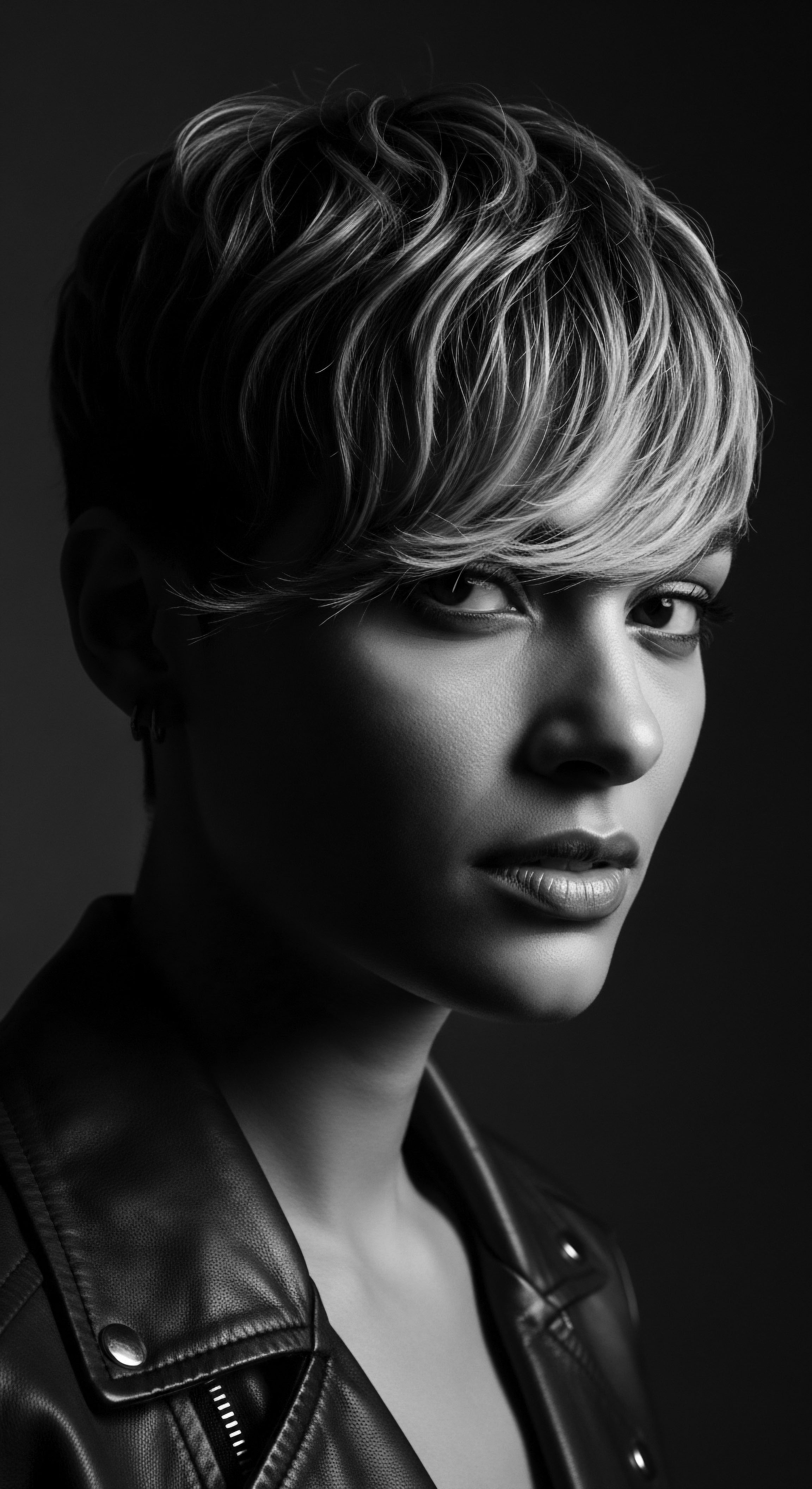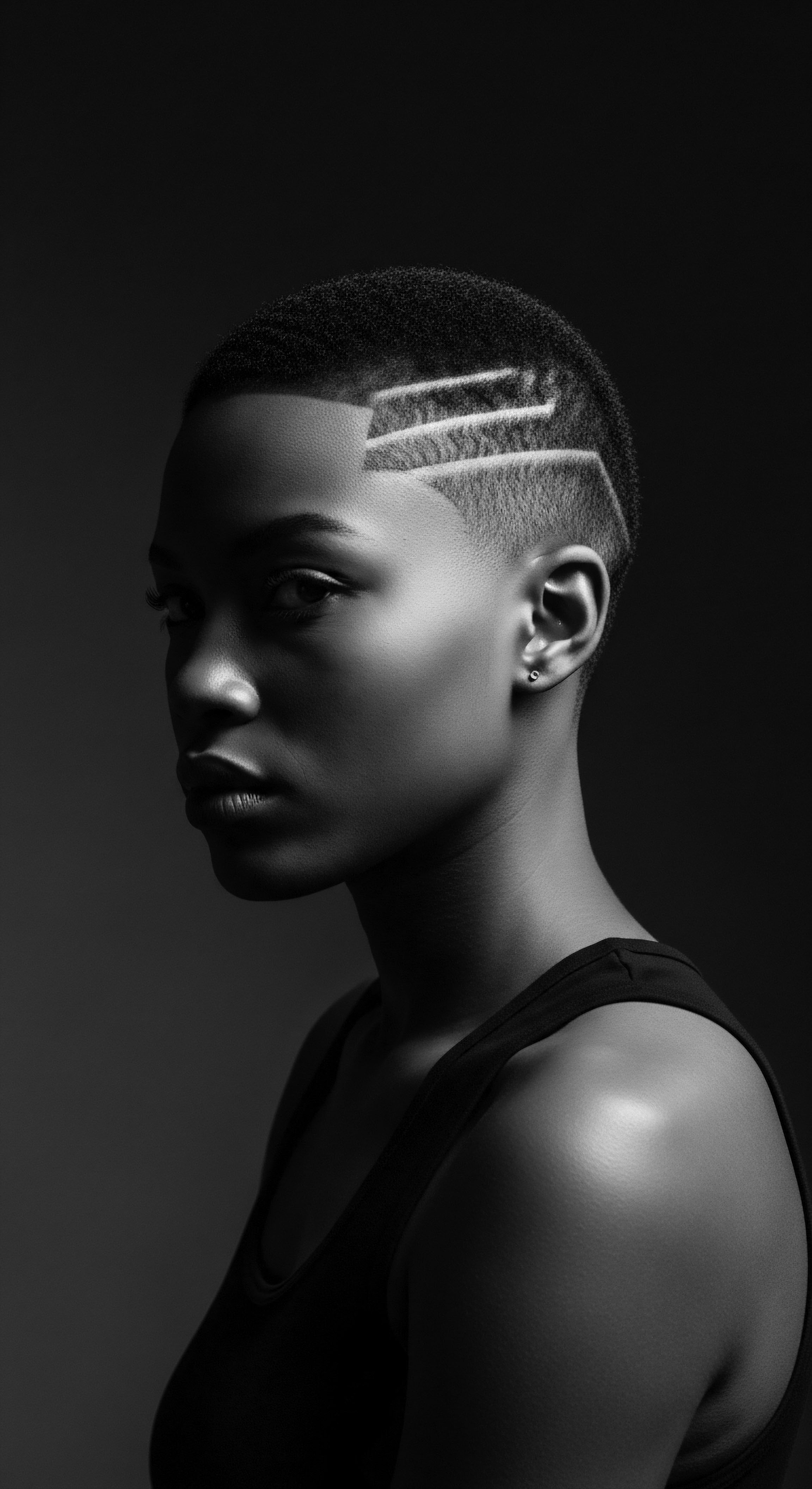The journey into Plant Botanical History, particularly as it intersects with textured hair heritage, is a profound expedition into ancestral wisdom, scientific validation, and the enduring spirit of Black and mixed-race communities. Roothea’s exploration of this field is a deep meditation on how the earth’s verdant offerings have long served as a wellspring of beauty, healing, and cultural expression for our hair. This is not a mere recounting of historical facts; it represents a living, breathing archive of connection, resilience, and identity, woven into the very strands of our being.

Fundamentals
The Plant Botanical History, in its most straightforward sense, represents the chronicle of how human societies have interacted with, understood, and utilized the botanical world across the ages. This involves tracing the discovery, classification, cultivation, and application of plants for various human needs—from sustenance and medicine to shelter and adornment. For those with textured hair, this designation carries a particularly intimate connotation, speaking to the ancient and continuous reliance on plant life for the fundamental care, maintenance, and styling of curls, coils, and waves.
Consider the earliest epochs, when human existence was inextricably linked to the immediate natural surroundings. Our ancestors, acutely attuned to the rhythms of the earth, discovered through trial and keen observation which leaves offered solace, which roots provided nourishment, and which fruits conferred beauty. This elemental understanding of botanicals laid the groundwork for sophisticated traditional practices that would span continents and millennia, particularly for hair. The earliest applications for hair care were deeply practical ❉ seeking plants to cleanse, to soothe irritated scalps, to provide slip for detangling, or to offer a protective barrier against environmental aggressors.
The fundamental meaning of Plant Botanical History, for textured hair heritage, traces the ancient human bond with the botanical world, revealing how ancestral communities first discerned plants’ intrinsic properties for hair care.

Early Foraging and Hair
Long before written records, before the meticulous classifications of modern botany, indigenous communities across Africa observed the natural world with a discerning eye. They identified plants possessing properties ideal for cleansing, conditioning, and protecting hair. The very concept of “clean” and “healthy” hair was intertwined with the accessible flora.
Think of the mucilaginous qualities of certain leaves or barks when steeped in water, transforming into a gentle, slippery liquid capable of detangling even the most resilient coils. These discoveries were not accidental; they stemmed from generations of observation, experimentation, and shared communal wisdom, a heritage of empirical knowledge.
Among these early botanical discoveries, many played a foundational role in ritualistic hair practices. For example, certain barks were ground into powders, mixed with water or natural fats, and applied to the scalp and hair not merely for their cosmetic value, but for their perceived spiritual cleansing or protective attributes. Such uses underscored a world where the practical, the sacred, and the aesthetic were harmoniously entwined within daily life.

The Cradle of Cultivation
As human societies transitioned from nomadic foraging to settled agricultural communities, the relationship with plants deepened. Cultivation meant a more consistent supply of favored botanicals, allowing for more regular and specialized hair care rituals. This period saw the deliberate propagation of plants known for their benefits to textured hair, securing their place within the ancestral care repertoire. The exchange of seeds and knowledge between communities further enriched these traditions, with specific plant species becoming synonymous with particular hair outcomes or ceremonial significance.

Initial Plant-Hair Interactions
The initial interactions between humans and plants regarding hair were governed by practical necessity and immediate availability. Yet, these simple beginnings blossomed into a complex system of care. For instance, the fatty acids present in certain nuts or seeds provided essential lubrication and protection for hair, while the saponins found in other plants offered mild, effective cleansing without stripping vital moisture. This intuitive understanding, passed down through oral traditions and communal demonstrations, formed the bedrock of textured hair care, a legacy carried within the very structure of the hair itself.
- Shea Butter Tree (Vitellaria paradoxa) ❉ Originating in West and East Africa, its nuts yield a butter prized for moisturizing and protecting skin and hair.
- African Black Soap (derived from plantain peels, cocoa pods, palm kernel oil) ❉ A traditional West African cleanser, it offers deep cleansing and exfoliation for both skin and hair.
- Moringa Tree (Moringa oleifera) ❉ Native to parts of Africa and Asia, various parts are used for nutritional and medicinal purposes, including hair health due to its vitamin and mineral content.
| Botanical Source Acacia Bark (e.g. Omutyuula tree) |
| Traditional Application Ground bark paste mixed with fat |
| Perceived Benefit to Hair (Ancestral Wisdom) Promoting hair growth and preventing breakage, often applied during coming-of-age ceremonies. |
| Botanical Source Okra (Abelmoschus esculentus) |
| Traditional Application Mucilaginous extract from pods |
| Perceived Benefit to Hair (Ancestral Wisdom) Conditioning, detangling, and providing slip; believed to nourish hair and scalp. |
| Botanical Source Chebe Powder (Croton zambesicus seeds) |
| Traditional Application Mixed with oils, applied to hair lengths |
| Perceived Benefit to Hair (Ancestral Wisdom) Strengthening, moisturizing, and length retention, particularly among Bassara women of Chad. |
| Botanical Source These early uses laid the foundation for textured hair care, demonstrating an intuitive understanding of botanical properties that continues to influence practices today. |

Intermediate
Moving beyond the foundational understanding, the intermediate meaning of Plant Botanical History expands to consider the more structured aspects of plant knowledge, including rudimentary classification, the deliberate cultivation of specific species, and the significant role of trade routes in disseminating botanical wisdom. For textured hair heritage, this signifies a period where plant-based hair care evolved from localized subsistence to a more formalized system, deeply intertwined with cultural identity and communal practices across the African continent and into the diaspora. This epoch showcases how ancestral populations not only harnessed plant properties but also organized their knowledge, shaping complex beauty rituals.
The movement of plants, whether through intentional propagation or accidental dispersal, mirrors the intricate pathways of human migration and exchange. As communities grew and interacted, so did their botanical lexicons and the repertoire of plants used for hair. This exchange was critical in adapting and enriching hair care traditions, ensuring that practices remained responsive to changing environments and social landscapes. The intentional application of specific botanicals became a distinguishing mark of tribal affiliation, social status, and personal expression, carrying deep cultural weight.
The intermediate understanding of Plant Botanical History reveals how structured plant knowledge, cultivation, and trade routes shaped complex, culturally significant hair care systems across the African continent and within diasporic communities.

The Silk Roads of Seed and Strand
Long before colonial incursions, vibrant networks of trade crisscrossed Africa, extending into Asia and the Middle East. These routes facilitated the exchange not only of goods but also of ideas, techniques, and crucially, botanical specimens. Seeds traveled alongside textiles and spices, introducing new plants with novel properties for hair care.
The movement of ingredients like Moringa, Shea Butter, and various fragrant resins across vast distances meant that a wider palette of botanical resources became available for ancestral hair rituals. This historical reality underscores a dynamic, interconnected past, where botanical knowledge was a fluid entity, constantly being refined and expanded.
Consider, for instance, the journey of plants like Lawsonia inermis, commonly known as Henna. While often associated with South Asian and Middle Eastern cultures, its use for hair coloring and conditioning has historical roots and significant adoption in parts of North and East Africa. This botanical’s prevalence illustrates the ancient interconnectedness of knowledge systems, where a plant’s journey became a part of diverse cultural hair stories.

Traditional African Botanicals
Within the rich tapestry of African societies, a vast pharmacopoeia of indigenous plants was meticulously documented and utilized for hair care. Each region, each community, developed its own specialized understanding of local flora, transforming natural resources into sophisticated hair treatments. These traditional botanical practices often involved intricate preparation methods, reflecting a deep respect for the plants themselves and the wisdom passed through generations.
- Rooibos Tea (Aspalathus linearis) ❉ Originating from South Africa, this caffeine-free tea is rich in antioxidants and minerals, believed to support hair health, prevent premature graying, and stimulate growth.
- Baobab Oil (Adansonia digitata) ❉ Derived from the “Tree of Life” native to Africa, its oil is laden with vitamins and fatty acids, ideal for moisturizing dry hair, strengthening strands, and reducing breakage.
- Ambunu (various Celastraceae species) ❉ An ancient Chadian herb used as a natural cleanser and conditioner, providing slip for detangling while leaving hair soft and shiny.

Early Diasporic Adaptations
The cruel disruptions of the transatlantic slave trade presented an unparalleled challenge to the continuity of these botanical traditions. Stripped of their ancestral lands and often their hair care implements, enslaved Africans carried invaluable botanical knowledge within their memories and, in some poignant instances, as seeds braided into their hair. This act of resistance and preservation ensured that fragments of Plant Botanical History, particularly related to hair, journeyed across oceans. In the Americas and the Caribbean, this ancestral knowledge hybridized with indigenous plant wisdom, creating new, resilient forms of hair care.
For example, the widespread use of Okra in African diasporic communities, not only for culinary purposes but also as a mucilaginous agent for hair, stands as a testament to this adaptation and cultural preservation. Its ability to condition and detangle hair became a vital resource in environments where traditional African botanicals might have been scarce. These adaptations underscore the ingenuity and determination of our ancestors to maintain their connections to their heritage through the practical application of plant wisdom.

Academic
From an academic perspective, the Plant Botanical History denotes a complex, interdisciplinary field of study. Its core explanation scrutinizes the co-evolution of human societies and botanical understanding, encompassing ethnobotany, economic botany, historical ecology, and the cultural transmission of plant-based practices. Within the specific purview of textured hair care, this designation analyzes the intergenerational wisdom intrinsically woven into hair traditions across the African diaspora.
It dissects the intricate interplay of botanical resources, traditional technological innovations, socio-economic structures, and identity formation, all realized through the historical application of plant-derived materials to hair. This scholarly lens moves beyond mere description, delving into the underlying mechanisms, the socio-historical forces that shaped these practices, and their profound implications for contemporary understandings of beauty, wellness, and selfhood.
The academic investigation of Plant Botanical History requires rigorous methodology, often drawing from anthropology, archaeology, chemistry, and genetics. It seeks not only to identify the plants used but to comprehend the chemical properties that conferred their efficacy, the cultural contexts that imbued them with meaning, and the historical trajectories that led to their dissemination or marginalization. It is a field that respects traditional knowledge systems as valid forms of scientific inquiry, recognizing the centuries of empirical observation that informed ancestral practices.
The academic meaning of Plant Botanical History for textured hair heritage involves a scholarly exploration of how human-plant co-evolution, cultural transmission, and ethnobotanical knowledge have shaped intricate, identity-affirming hair care practices across the African diaspora.

Ethnobotanical Cartographies of Hair
Ethnobotany, a specialized branch of this field, meticulously maps the relationship between people and plants. For textured hair, this involves charting the geographical origins of key botanicals, understanding their traditional cultivation methods, and documenting the specific techniques used for their preparation and application. This scholarly endeavor often reveals sophisticated indigenous knowledge systems that predate Western scientific classification, offering profound insights into sustainable resource management and holistic wellness.
A noteworthy example is the study of Chebe Powder, a traditional hair treatment used by the Bassara (also known as Baggara Arab) women of Chad. These women are renowned for their remarkable hair length, often reaching past their waist, a characteristic attributed to their consistent use of this botanical mixture.
This practice is not merely cosmetic; it is deeply embedded in social rites and cultural identity. Historical accounts suggest that in some Bassara communities, the meticulous application of Chebe powder, made from a blend of Croton zambesicus seeds, Mahllaba Soubiane (cherry kernels), cloves, resin, and stone scent, becomes part of multi-year hair rituals. One account from research on Chadian hair traditions indicates that women apply this mixture to the lengths of their hair, often saturating it, then braiding or twisting the hair, which helps to minimize breakage and retain moisture in the harsh Sahelian climate. This sustained practice creates a protective barrier, allowing the hair to grow to extraordinary lengths.
The continuity of this tradition, passed through generations, offers a compelling case study of how deep ethnobotanical understanding directly correlates with tangible outcomes for textured hair. This systematic application and the resulting hair health are not simply anecdotal; they represent an observable, long-term commitment to a plant-based hair care system that demonstrably supports significant length retention in a specific hair type often prone to breakage. This particular instance serves as a compelling demonstration of the interplay between botanical knowledge and hair vitality.

The Science of Ancestral Wisdom
Modern scientific inquiry frequently provides validation for long-standing ancestral hair practices. The mucilaginous qualities of plants like Okra, for example, which impart slipperiness to its extract, are now understood to be due to polysaccharides that coat the hair shaft, providing detangling benefits. Similarly, the rich fatty acid profile of Shea Butter—composed of oleic, stearic, linoleic, and palmitic acids—explains its efficacy as an emollient and moisturizer, protecting textured hair from dryness and environmental damage.
Research into African botanicals used for hair care has even begun to explore connections between topical plant applications and systemic health, with studies noting that many plants traditionally used for hair conditions also exhibit antidiabetic potential, hinting at a “topical nutrition” hypothesis for scalp health. This growing body of evidence affirms that ancestral practices were not arbitrary but were rooted in an intuitive, deep understanding of plant chemistry and physiology.
| Botanical Ingredient (Common Name & Scientific Name) Shea Butter (Vitellaria paradoxa) |
| Traditional Use for Textured Hair Deep conditioning, sealing moisture, protection from sun and harsh elements. |
| Modern Scientific Understanding/Correlation Rich in oleic and stearic acids, acting as an excellent emollient and moisturizer; contains vitamins A, E, F, and UV protective compounds. |
| Botanical Ingredient (Common Name & Scientific Name) Chebe Powder (Croton zambesicus) |
| Traditional Use for Textured Hair Length retention, strengthening strands, reducing breakage by coating hair fibers. |
| Modern Scientific Understanding/Correlation The composite blend helps to create a protective barrier, reducing mechanical stress and moisture loss, leading to less breakage and more length retention. |
| Botanical Ingredient (Common Name & Scientific Name) African Black Soap (Plantain peels, Cocoa pods, Palm kernel oil) |
| Traditional Use for Textured Hair Gentle cleansing, addressing scalp issues like dandruff. |
| Modern Scientific Understanding/Correlation Contains natural saponins for cleansing; rich in vitamins A & E, and antioxidants for scalp health and gentle exfoliation due to plant ash content. |
| Botanical Ingredient (Common Name & Scientific Name) Moringa (Moringa oleifera) |
| Traditional Use for Textured Hair Nourishing scalp, promoting hair growth, improving hair texture. |
| Modern Scientific Understanding/Correlation High concentration of vitamins (C, A, E), minerals (iron, potassium), and antioxidants that support hair follicle health and mitigate oxidative stress. |
| Botanical Ingredient (Common Name & Scientific Name) The enduring efficacy of these ancestral remedies is increasingly corroborated by scientific research, bridging ancient wisdom with contemporary understanding. |

Resilience and Reclamation
The Plant Botanical History of textured hair is also a narrative of profound resilience. Despite centuries of systemic oppression and the devaluation of Black hair and its associated traditions, botanical knowledge persisted. The act of tending to textured hair with plant-derived ingredients became an intimate space of cultural preservation, a silent act of defiance against narratives that sought to diminish Black identity. The recent resurgence of the natural hair movement, globally, represents a powerful reclamation of this heritage.
It is a collective turning back to the earth, to ancestral wisdom, recognizing that the roots of true hair wellness lie in the enduring gifts of the botanical world. This movement critically assesses the impact of colonial beauty standards, seeking to decolonize beauty practices by prioritizing plant-based, traditionally informed care.
The study of this heritage calls for an ethical approach, acknowledging the origins of these practices and honoring the communities who have preserved this knowledge. It emphasizes sustainable sourcing of botanicals and equitable partnerships with indigenous cultivators, ensuring that the global appreciation of these plant-based remedies benefits those whose ancestors safeguarded them for generations. This academic understanding of Plant Botanical History is not merely about facts; it is about justice, recognition, and the celebration of an unbroken lineage of botanical wisdom deeply connected to the identity and care of textured hair.

Reflection on the Heritage of Plant Botanical History
The continuous examination of Plant Botanical History, particularly as it relates to textured hair, reveals a narrative of profound interconnectedness—a vibrant story that stretches from the earliest murmurs of ancestral discovery to the confident declarations of self-acceptance today. We are not simply tracing the uses of plants; we are uncovering the very architecture of a living heritage, a testament to the ingenuity, resilience, and spiritual depth of Black and mixed-race communities. Each leaf, each seed, each bark employed in the care of textured hair carries the echoes of hands that knew the earth intimately, of minds that understood its subtle powers, and of hearts that found solace and expression in its gifts.
Our hair, with its unique coils and curls, stands as a tangible link to this botanical lineage. The rituals of applying natural butters, of cleansing with plant-derived saponins, of infusing oils with fortifying herbs, are not distant historical footnotes; they are living traditions that breathe in our contemporary spaces. The wisdom contained within Plant Botanical History is a guiding light, reminding us that the truest nourishment for our hair often lies in returning to the source, to the earth’s timeless remedies. It encourages us to approach hair care with reverence, recognizing it as a continuation of ancestral dialogues with nature.
This journey through Plant Botanical History is, at its heart, an invitation to a deeper relationship with our hair and with ourselves. It is a call to honor the ancestral practices that safeguarded our hair’s vitality and beauty, even through periods of immense challenge. The strands we wear are not just personal expressions; they are living archives, holding the legacy of botanical wisdom and the enduring spirit of a people.
As Roothea often reflects, each curl, each twist, is a tender thread in a grand, unbound helix, connecting us to a heritage rich in botanical knowledge, a source of strength, beauty, and unwavering identity. This collective remembrance through plants empowers us to shape a future where textured hair is celebrated in all its natural splendor, a future continually rooted in the profound wisdom of our past.

References
- Carney, Judith A. “African Traditional Plant Knowledge in the Circum-Caribbean Region.” Journal of Ethnobiology 23, no. 2 (2003) ❉ 167-185.
- Ejoh, R. A. and P. M. Ngu. “Medicinal and Nutritional Benefits from the Shea Tree- (Vitellaria Paradoxa).” International Journal of Medicinal Plants Research 1, no. 3 (2012) ❉ 37-43.
- Hughes, K. Ho, R. & Sadgrove, N. J. “Cosmetopoeia of African Plants in Hair Treatment and Care ❉ Topical Nutrition and the Antidiabetic Connection?” Diversity 16, no. 2 (2024) ❉ 96.
- Muimba-Kankolongo, A. “Okra (Abelmoschus esculentus).” In Traditional African Vegetables ❉ A Technical Guide to Production and Use, 2018.
- Penniman, Leah. Farming While Black ❉ Food Justice, Abolition, and Our Ancestors’ Table. Chelsea Green Publishing, 2018.
- Sadgrove, N. J. “The new paradigm for androgenetic alopecia and plant-based folk remedies ❉ 5α-reductase inhibition, reversal of secondary microinflammation and improving insulin resistance.” Journal of Ethnopharmacology 227 (2018) ❉ 206-236.
- Sharaibi, O. J. et al. “Cosmetic Ethnobotany Used by Tribal Women in Epe Communities of Lagos State, Nigeria.” Journal of Complementary Medicine and Alternative Healthcare 12, no. 4 (2024) ❉ 555845.
- Siemonsma, J. S. “Okra.” Plant Resources of Tropical Africa, 2015.
- Van der Waal, J. “The Mbalantu Women of Namibia and Their Eembuvi Plaits.” Gondwana Collection Namibia, 2012.
- Volkmann, Mary Jane. Mbalantu. Self-published, 1997.
